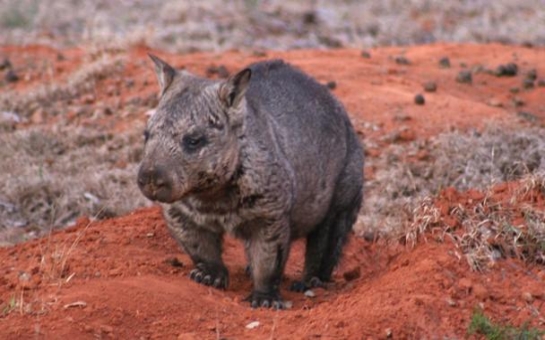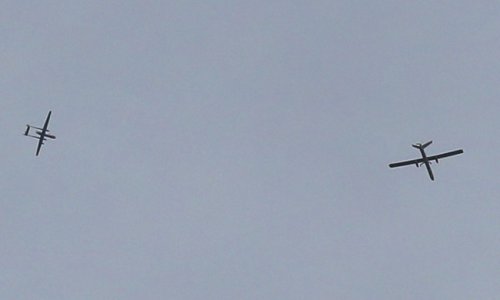Follow us !
Protecting a wombat species that is as fast as Usain Bolt
World
09:15 | 16.01.2014

Protecting a wombat species that is as fast as Usain Bolt
It was not the most glamorous way to spend a week’s holiday: examining, feeling and sniffing wombat scat. But in a strange way, it was also very rewarding.“Look at the way he’s stacked them! Beautiful, really square,” said Alan Horsup, a scientist with Australia’s Department of the Environment and Heritage Protection.Horsup works in northern hairy nosed wombat conservation, which at the time involved holding a piece of wombat excrement between his index finger and thumb. According to scientists, the stacking of the animal’s dung could be a sign of status.In central Queensland’s Epping Forest National Park, far from the beaches of a typical tropical holiday, I had volunteered to spend my time off helping scientists conduct population monitoring to determine how many northern hairy nosed wombats still exist.Scientists believe the number left in the world is about 200 – a slight increase from the mid 1980s when there were only 35 – but the northern hairy nosed wombats remain critically endangered, largely because of competition with cattle and sheep for food, as well as drought and dingo and feral dog attacks. Today, approximately 185 northern hairy nosed wombats reside at Epping Forest and another 15 live in the 105-hectare Richard Underwood Nature Refuge nearby, making these the only northern hairy nosed colonies in the world. Northern hairy nosed wombats can only be found in the wild; their shy natures making the nocturnal marsupials ill-prepared to cope with the stress of captivity.There are two other species of wombat, the common (or bare-nosed) wombat, which is not endangered and is found on the southeastern coast of Australia (in New South Wales, Victoria and Tasmania) and the southern hairy nosed wombat, which is endangered and is found in arid, sandy pockets in the southern part of Australia (in South Australia and Western Australia). The Northern hairy nosed wombat is the largest of all the three species, weighing up to 40kg and measuring about 1m long (the females are slightly heavier than the males).Originally hailing from the coast city of Sydney, I was unused to the dry, tropical landscape of central Queensland. Although it was only about 10 am, it was already hot, hitting about 30C and it would head to 38C by midday.Scientists only invite a handful of volunteers throughout the year to participate in the programme and interested parties have to apply for a government permit to enter the reserve . In addition to population monitoring, volunteers check for breakage in the 2m-high, 20km-long, 1m-deep anti-dingo and dog fence that surrounds the park, and fill up water containers placed around the reserve for the wombats each day. In this arid environment, water is key – but the latter job can feel unnecessary when you realise the animals rarely seem to drink, preferring to get their fluid from the grass they eat, and staying cool in their burrows during the day.Volunteer caretakers, who need to be familiar with living in the bush, managing a remote reserve and knowing what to do if there is an emergency, are required to live in the park for about a month at a time, reporting on bush fires and recording data taken from cameras at the wombat watering stations.On my first day, as Horsup and I headed out from camp in search of wombat evidence, whistling kite birds were circling above, indicating a dead animal nearby – perhaps a kangaroo, possibly a wombat. Puffball fungi grew from the dusty soil and dead cane toad carcasses were turned upside down, the birds having learned to avoid the pest’s toxic chemicals by eating them from underneath. We were careful to watch for black-headed pythons as we walked.We came to a hummocky, undulating area of soil about 10sqm beside a gidgee tree. Hairy nosed wombats often choose to dig their burrows, made up of a series of tunnels, below these acacia trees, also known as stinking wattle as they smell like sour cabbage. Scientists think the wombats use the tree’s roots to give their home structural strength in the sandy soil, and they dig them out using their very strong, muscular bodies and sharp claws.Indeed, now I could see why wombats are often referred to as the engineers of the mammal world. Their burrows can be up to 90m long and are essential for helping the animals regulate their temperature and hide from predators.Horsup jumped up and down on top of the soil, hoping to stir the creature below. Wombats generally live alone in their burrows, but sometimes there are more than one. Other animals, such as echidnas, also live in them. “Definitely active, this burrow,” he said, as we heard the wombat snorting and running deeper into the tunnels below our feet.Despite their short legs and chunky furry bodies, northern hairy nosed wombats can run at a speed of about 40km/h over short distances. In comparison, the sprinter Usain Bolt – widely regarded as the fastest person in the world – hits speeds of about 45km/h.Ukulele under the starsFor a week, this was our life: setting out after dawn, spending the early morning looking for wombat scat and jumping up and down on their burrows. In the midday’s heat we relaxed. But as the animals are nocturnal, I’d yet to see an actual wombat. On my last night, we ate a dinner of delicious stew at a long table under the stars, surrounded by the series of corrugated iron huts that we slept in.The accommodation in the park has come a long way since the 1980s, Horsup said, when there was no air-conditioning in the bedrooms or flushing toilets. Now the huts even have a satellite phone.While Horsup entertained our group of six by singing and playing the ukulele, we talked about the wombats.“It’s a shame the wombats are so shy. It’s so hard to help them as they keep away from people,” said Jim Price, one of the caretakers. “If you put out food or water they will rarely touch it.”But for as much time as we spent looking for wombats, we ended up not needing to go far in order to see one. Just metres from our camp, under the light of the moon, a wombat stood, having just emerged from his burrow behind the outdoor toilet a few metres away. The marsupial was hungry and looking for grass to eat, peering at us to see whether it was safe to explore further.Horsup’s flashlight illuminated his long whiskers, pointy ears and lovely, grey-brown fur. He stood about 1m tall and looked to weigh about 35kg. The marsupial stared back at us, motionless.“Could it be the Dunny Wombat come back?” Horsup questioned. It had been some time since the team had see the creature who had often left tracks by the outdoor toilet – known colloquially in Australia as the dunny. They’d believed he had moved into another burrow further from camp.Having spent all week looking at the markings wombats leave behind, I had wanted nothing more than to see a northern hairy nosed in the flesh. But now that I had, I felt bad shining a torch in his eyes, making him uncomfortable and exposed.After a few moments, I gestured to Horsup that we had seen enough, and left the marsupial to find his breakfast of grass underneath the stars.PracticalitiesVolunteering at the park requires invitation from the scientists. Volunteers should be physically fit and used to dry, tropical weather and have experience living in the bush on a remote station. Often they take on local farming and conservation people as they used to the work and environment. You need a permit from the government to enter the reserve. (BBC)ANN.Az










